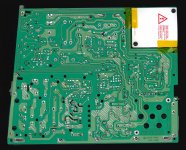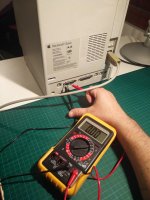Hello from Lisbon 
Although this is my first post, I’ve been visiting this forum looking for clues on what might be wrong with a 1991 Macintosh Classic.
I’ll try to clearly describe what happened so that owners with similar symptoms will be able to repair their Classics.
I have no experience in electronics so please be patient and use a descriptive language for troubleshooting.
I bought it knowing it didn’t work. The early symptoms were:
I proceeded to remove the rear cover and noticed that, although it had been repaired in the past – some of the Analog Board capacitors were replaced – it was in general mint condition. The keyboard keys still had the mould texture so I guess it just stood in a corner, not being used.
The insulator vinyl was missing as were all four plastic clips.
It included the 40MB SCSI HDD (it spins and sounds “normal” when connected to an ATX power source) and a full 3MB memory expansion board.
The Logic Board capacitors were still the original ones. I did noticed some mild electrolyte spilling – which I carefully washed away – but decided not to replaced them while I was troubleshooting the booting problem.
With the rear cover off, connected to the power outlet and switched on, I could feel some warmth with my hand over some points in the back of the analog board, mainly near the flyback transformer and the QP2.
While tinkering with a digital multimeter, near the QP2 transistor, I caused the fuse to blow.
After that accident any fuse would blow once I attempted to turn the Classic on.
Following this thread:
https://68kmla.org/forums/index.php?/topic/22946-macintosh-classic-keeps-blowing-fuses/
I proceeded to replace:
I also replaced the usual bunch of capacitors:
(The only reference I had was based on the previous values installed, please inform if you find any abnormal values)
As a result of these replacements I’m back to square one. The fuse no longer blows but there’s no action whatsoever.
Yesterday I looked at Larry Pina’s 1993 edition of “Repair and Upgrade Secrets”.
In the section dedicated to the Classic’s Analog Board troubleshooting (chapter 9, page 174) he mentioned the RP2 surgistor (?) could be at fault. 12 Ohm=good, 0.0L mOhm=bad.
But I don’t know how to use the Digital Multimeter to test this. I resoldered it, but to no avail
Additional Data
I attached a picture of the back of the analog board after having removed the bad capacitors and giving it a thorough clean.
What can I do now?
Do you have any idea/procedure I could try?
It’s so sad to see this beauty of a computer standing there, dead.
I would love to hear from this community.
Thanks

Although this is my first post, I’ve been visiting this forum looking for clues on what might be wrong with a 1991 Macintosh Classic.
I’ll try to clearly describe what happened so that owners with similar symptoms will be able to repair their Classics.
I have no experience in electronics so please be patient and use a descriptive language for troubleshooting.
I bought it knowing it didn’t work. The early symptoms were:
- No screen
- No disc activity
- No bong or any noise whatsoever
- Power cable was working
I proceeded to remove the rear cover and noticed that, although it had been repaired in the past – some of the Analog Board capacitors were replaced – it was in general mint condition. The keyboard keys still had the mould texture so I guess it just stood in a corner, not being used.
The insulator vinyl was missing as were all four plastic clips.
It included the 40MB SCSI HDD (it spins and sounds “normal” when connected to an ATX power source) and a full 3MB memory expansion board.
The Logic Board capacitors were still the original ones. I did noticed some mild electrolyte spilling – which I carefully washed away – but decided not to replaced them while I was troubleshooting the booting problem.
With the rear cover off, connected to the power outlet and switched on, I could feel some warmth with my hand over some points in the back of the analog board, mainly near the flyback transformer and the QP2.
While tinkering with a digital multimeter, near the QP2 transistor, I caused the fuse to blow.
After that accident any fuse would blow once I attempted to turn the Classic on.
Following this thread:
https://68kmla.org/forums/index.php?/topic/22946-macintosh-classic-keeps-blowing-fuses/
I proceeded to replace:
- QP2 - transistor - original: CET 48C0 CEF02N6 - replaced with: IRFBC40
- CP23 - blue ceramic capacitor - original: HR R 27 IJ 2KV - replaced with: (I will see it when I get home)
- RP40 - resistor - original: Red Red Brown Gold (220 Ohms 5%) - replaced with: (I will see it when I get home)
- DP5 - rectifier - original: BYT03 300 C039 - replaced with: (I will see it when I get home)
I also replaced the usual bunch of capacitors:
(The only reference I had was based on the previous values installed, please inform if you find any abnormal values)
- CP2 - 470uF - 35v - 10mm - 105°
- CP6 - 1000uF - 25v - 10mm - 105°
- CP7 - 1000uF - 25v - 10mm - 105°
- CP8 - 2200uF - 16v - 13mm - 85°
- CP9 - 470uF - 25v - 10mm - 85°
- CP10 - 470uF - 25v - 10mm - 85°
- CP12 - 1000uF - 25v - 10mm - 105°
- CP36 - 1000uF - 16v - 10mm - 105°
As a result of these replacements I’m back to square one. The fuse no longer blows but there’s no action whatsoever.
Yesterday I looked at Larry Pina’s 1993 edition of “Repair and Upgrade Secrets”.
In the section dedicated to the Classic’s Analog Board troubleshooting (chapter 9, page 174) he mentioned the RP2 surgistor (?) could be at fault. 12 Ohm=good, 0.0L mOhm=bad.
But I don’t know how to use the Digital Multimeter to test this. I resoldered it, but to no avail
Additional Data
- Analog Board: 820-0395-C, 240V, wired JP1 jumper.
I attached a picture of the back of the analog board after having removed the bad capacitors and giving it a thorough clean.
What can I do now?
Do you have any idea/procedure I could try?
It’s so sad to see this beauty of a computer standing there, dead.
I would love to hear from this community.
Thanks

Last edited by a moderator:







